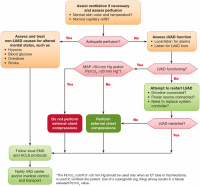Ventricular Assist Devices: Difference between revisions
From Protocopedia
No edit summary |
No edit summary |
||
| Line 43: | Line 43: | ||
'''TRANSPORT OF PATIENT:''' | '''TRANSPORT OF PATIENT:''' | ||
* '''ALL VAD | * '''ALL VAD patients must be transported to a VAD center.''' | ||
** Currently Advent Hospital Orlando and Orlando Regional Medical Center are the only local approved VAD centers. | ** Currently Advent Hospital Orlando and Orlando Regional Medical Center are the only local approved VAD centers. | ||
** Contact the VAD coordinator as soon as possible and notify them of the transport. | ** Contact the VAD coordinator as soon as possible and notify them of the transport. | ||
Latest revision as of 17:44, 14 March 2022
Section 4 - CARDIAC
4.14 VENTRICULAR ASSIST DEVICES
This Parameter applies to the management of patients who have a ventricular assist device (VAD) also referred to a left ventricular assist device (LVAD) implanted. The VAD is a mechanical pump used to support the heart’s pumping function and positive blood flow on individuals who have severe heart failure.
- Perform initial assessment: vital signs, oxygen saturation, pre-treatment 12-Lead ECG, focused history (SAMPLE, OPQRST), and physical exam. Inquire if the patient has an old ECG.
- Provide OXYGEN @ 100% via NRB mask or assist ventilations/oxygenation as indicated.
- Listen to heart sounds. The heart sounds may be faint.
- Check for a functioning VAD: These devices are usually implanted below the heart in the abdominal cavity area. Use a stethoscope to listen for constant humming or whirling sound. This sound confirms the VAD is functioning.
- The nature of the VAD function provides positive constant flow (it is a centrifugal pump) therefore a pulse may not be palpable in these patients.
- Blood Pressure: A manual blood pressure may not be obtainable. An automated blood pressure monitoring device may provide a reading with a narrow pulse pressure.
- Treatment of these patients must be based on the mean arterial pressure (MAP). The normal MAP should be between 60 and 90 mm/Hg.
- Pulse Oximetry: These readings may not be accurate due to the continuous flow provided by the VAD.
- Monitor side capnography for ventilation and oxygenation effectiveness.
UNRESPONSIVE PATIENT

- If the patient is unresponsive to stimuli:
- Open the airway and ventilate/oxygenate as necessary.
- Obtain a blood glucose level and treat per 5.10 Hypoglycemia parameter as needed.
- Listen for a functioning VAD by auscultating over the abdomen.
- If the VAD has a whirling sound it is properly functioning.
- DO NOT PERFORM CPR IF IT IS FUNCTIONING!
- A VAD or LVAD is surgically implanted to the left ventricle. External cardiac compressions may dislodge the VAD causing death.
- If the VAD is silent have the caregiver or family member check the device external pump controller and power supply.
- LISTEN TO THE CAREGIVER! These individuals are experts in these devices and know/understand how to operate and troubleshoot the system.
- VAD patients are instructed to always have a backup bag with 2 charged batteries and a second pump controller.
- Contact the LVAD coordinator on call (based at Florida South).
- If the VAD is inoperative despite troubleshooting and battery replacement, then CPR is indicated as per cardiac arrest parameter.
RESPONSIVE PATIENT:
- Perform a subjective interview to determine chief complaint and history of present illness.
- Monitor ECG and obtain a 12 lead ECG if chest pain, ischemic symptoms, shortness of breath or weakness is reported.
- Any cardiac dysrhythmias must be treated per the appropriate practice parameter.
- If electrical therapy is indicated on a conscious patient, the patient may be sedated (time permitting) as per parameter 2.04 Analgesia/Sedation.
- Establish IV access and provide fluid resuscitation as indicated based on patient’s condition and hydration status.
- Assess for any other concurrent medical conditions or symptoms and treat per the appropriate parameter.
TRANSPORT OF PATIENT:
- ALL VAD patients must be transported to a VAD center.
- Currently Advent Hospital Orlando and Orlando Regional Medical Center are the only local approved VAD centers.
- Contact the VAD coordinator as soon as possible and notify them of the transport.
- Don’t forget the family member/caregiver!
- The family member/caregiver must ACCOMPANY the patient in the ambulance.
- These individuals have intimate knowledge of the patient’s condition, the system and usually have legal authority to sign on behalf of the patient.
- Bring all VAD equipment, backup bags, charger and batteries with the patient!
